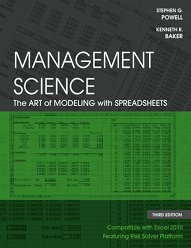About the Book
This is a book for business analysts about modeling. A model is a simplified representation of a situation or problem, and modeling is the process of building, refining, and analyzing that representation for greater insight and improved decision making. Almost anyone who uses spreadsheets in business has been involved with models and can benefit from formal training in the use of models.
Models also play a central role in management education. By using models, a business student can acquire a deep understanding of the various functional areas of business. But to fully understand the implications of these models, a student needs to appreciate what a model is and how to learn from it. Our book provides that knowledge.
With the spread of personal computers and electronic spreadsheets, managers and analysts can build their own models and produce their own analyses. This new kind of modeling is known as end-user modeling. In this environment, it becomes important to use time wisely in the modeling process. This book is designed to improve modeling efficiency by focusing on the most important tasks and suggesting how to avoid unproductive steps. This book is also designed to improve modeling effectiveness by introducing the most relevant analytic methods and emphasizing procedures that lead to the deepest business insights.
New in the Third Edition
In this Third Edition we have updated the contents to Excel 2010 and converted to Risk Solver Platform for Education. Risk Solver Platform for Education replaces four separate software tools used in previous editions: the Sensitivity Toolkit, Premium Solver, Tree Plan, and Crystal Ball. Risk Solver Platform for Education is an integrated add-in to Excel that performs sensitivity analysis, optimization, decision trees, and simulation. To exploit its capabilities fully, we have also added a new Chapter 14 on the Evolutionary Solver and substantially revised Chapter 16 (now Chapter 17) on Optimization in Simulation.
To the Reader
Modeling, like painting or singing, cannot be learned entirely from a book. However, a book can establish principles, provide examples, and offer additional practice. We suggest that the reader take an active learning attitude toward this book. This means working to internalize the skills taught here by tackling as many new problems as possible. It also means applying these skills to everyday situations in other classes or on the job. Modeling expertise (as opposed to modeling appreciation) can be acquired only by doing modeling. There is no substitute for experience.
The book is organized into five parts:
Spreadsheet modeling in the context of problem solving (Chapters 1–4)
Spreadsheet engineering (Chapters 5 and 6)
Data analysis and statistics (Chapters 7–9)
Optimization (Chapters 10–14)
Decision analysis and simulation (Chapters 15–17)
Students can find spreadsheet files for all models presented in the text on this website at the Text Figures link. For access to the Risk Solver Platform for Education software, contact your course instructor or Frontline Systems (email academic@solver.com or call 775-831-0300.)
To the Teacher
It is far easier to teach technical skills in Excel or in management science than it is to teach modeling. Nonetheless, modeling skills can be taught successfully, and a variety of effective approaches are available. Feedback from users of our book and from reviewers of previous editions suggests that there are almost as many course designs as there are instructors for this subject. Our book does not represent an idealized version of our own course; rather, it is intended to be a versatile resource that can support a selection of topics in management science, spreadsheet engineering, and modeling craft.
All spreadsheet files for the models in the text, as well as PowerPoint slides, are available to adopters. In addition, we provide some sample syllabi at the Syllabi link to suggest the course designs that other instructors have delivered with the help of this book. For access to the Risk Solver Platform for Education software, contact Frontline Systems (email academic@solver.com or call 775-831-0300.)
Software Accompanying the Text
Users of the Third Edition have access to spreadsheet files for all the models presented in the text on this website at the Text Figures link. Users also have access to Risk Solver Platform for Education, an integrated software platform for sensitivity analysis, optimization, decision trees, and simulation. Risk Solver Platform for Education replaces software in previous editions for the following purposes:
Sensitivity Analysis (in place of the Sensitivity Toolkit in Chapters 6 and 10–17);
Optimization (in place of Premium Solver for Education in Chapters 10–14);
Decision Tree Analysis (in place of Tree Plan in Chapter 15);
Monte Carlo Simulation (in place of Crystal Ball 7 Student Edition in Chapters 16 and 17).
Purchasers of this text (and its electronic version) have access to Risk Solver Platform for Education either through their course instructor or Frontline Systems (email academic@solver.com or call 775-831-0300).
Table of Contents
1. Introduction
2. Modeling in a Problem-Solving Framework
3. Basic Excel Skills
4. Advanced Excel Skills
5. Spreadsheet Engineering
6. Analysis Using Spreadsheets
7. Data Analysis for Modeling
8. Regression Analysis
9. Short-Term Forecasting
10. Nonlinear Optimization
11. Linear Optimization
12. Optimization of Network Models
13. Integer Optimization
14. Optimization of Non-Smooth Models
15. Decision Analysis
16. Monte Carlo Simulation
17. Optimization in Simulation
Detailed Table of Contents (Word file)
